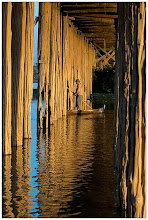
Feb 27, 2008
Feb 25, 2008
ေစတနာေတြ
ေရးသူ- စစ္ျငိမ္းဒီေရ
တခါတုန္း က ေတာ မက် ျမိဳ ့မက် ေဒသ တစ္ခုမွာ နအဖ စစ္သား လူမုိက္ တစ္
ေယာက္ရယ္၊ ႏွစ္လုံး ထီ ေကာ္မရွင္ ေရာင္းတဲ့ ၾကံဖြတ္ တစ္ေယာက္ ရယ္၊ 109…
110.. အရန္ မီးသတ္ တစ္ေယာက္ရယ္၊ သူငယ္တန္းကို သုံးႏွစ္က်လုိ ့ ေက်ာင္းထြက္
ခဲ့တဲ့ ၾကက္ေျခနီ တစ္ေယာက္ရယ္ သူငယ္ခ်င္း ေလးေယာက္ ရွိခဲ့ပါတယ္။
တေန ေတာ့ ၾကက္ေျခနီ သူငယ္ခ်င္း ဟာ ေႁမြ ကိုက္ ခံ ရျပီး ေသ ပါ ေလေရာ။ ဒါနဲ႕
က်န္တဲ့ သူငယ္ခ်င္း သုံးေယာက္ လဲ စိတ္မေကာင္းျခင္း မ်ားစြာနဲ ့ ကြယ္လြန္သူ
သူငယ္ခ်င္း အသုဘ ကို လုိက္ပို ့က်တာေပါ့။ သခၤ်ဳိင္းကုန္း မွာ အသုဘ ကို အေခါင္း
ပိတ္ ခ်ိန္လည္း ေရာက္ေရာ အရန္မီးသတ္ က စ ေျပာတယ္။ ... သူငယ္ခ်င္း တုိ႕
...ေသသြားတဲ့ ဒုိ ့သူငယ္ခ်င္း ..ေနာက္ဘ၀ မွာ တစ္ခုခု ၀ယ္စားဖုိ ့... ငါတုိ ့ သုံး
ေယာက္.. တစ္ေယာက္ကုိ..ပုိက္ဆံ ငါးရာ စီ.. စုျပီး ထည့္ေပးလုိက္ရင္.. ေကာင္း
မယ္ကြ။
ၾကံဖြတ္ လုပ္သူ သူငယ္ခ်င္း က လဲ...ေအး ေကာင္းသာဘဲ..မင္းအၾကံ။ အဲဒီ အခ်ိန္
မွာ စစ္သား သူငယ္ခ်င္း က ဘာေျပာလဲ ဆုိေတာ့.....မင္းတုိ ့ ႏွစ္ေယာက္....တစ္
ေယာက္ ငါးရာစီ ငါကုိ ေပးေလ...ငါစီမွာ ဘဏ္က ခ်က္စာအုပ္ ပါတယ္...1500 လုိ႕
ငါေရး ေပးလုိက္မယ္....လုိ ့ဆုိပါတယ္။ ဒါနဲ႕ပဲ နအဖ စစ္သား လုပ္သူက က်န္
ႏွစ္ေယာက္ စီ က ေငြ 500 စီ ယူျပီး သူ ့အိပ္ထဲ ကို ထည့္လုိက္တယ္။ ျပီးေတာ္
1500 တန္ ခ်က္လက္မွတ္ ကို ကြယ္လြန္သူ ၾကက္ေျခနီ သူငယ္ခ်င္း ရဲ ့အသုဘ
အေခါင္းထဲ ထည့္ေပး လုိက္ပါေတာ့တယ္။ ျပီးေတာ္ သူက ေျပာပါတယ္…ငါတုိ႕
ေစတနာေတြ......သူ သိမွာပါ...တဲ့။
Feb 24, 2008
တိုးတက္လာတဲ့ ျမန္မာ့ ရုပ္ရွင္
ျမန္မာျပည္က ဒါရုိက္တာၾကီးမ်ား ၀င္ေငြ ရရင္ ျပီးေရာ ဆုိတဲ့ သေဘာထားနဲ ့
ကုိလုိနီ နယ္ခ်ဲ ့ ဆန္႕က်င့္ေရး ကားေတြ ရုိက္ကူး ရာ မွာ နည္းနည္း ေလာက္
ေတာ့ သတိ ျပဳၾက ပါအုံးဗ်ာ။ ဒုိ ့ေသြးနဲ ့ ရင္းတဲ့ ငါတုိ ့ေျမ ဇာတ္လမ္းမွာ ကိုရန္ေအာင္
တုိ ့ နန္းဆုရတီစုိး တုိ ့ ေနတဲ့ ျမဳိ ့ က အိမ္မွာ တီဗြီ ကို ျမင္ေတြ ့ ရပါတယ္။ ျပီး ေတာ္
ဇာတ္ ၀င္ ခန္း တစ္ခု မွာ လဲ တီအီး 11 ကားတစ္စီး ကို ေတြ ့ရပါတယ္။ ျမန္မာျပည္
မွာ အဂၤလိပ္ ကိုလုိနီ ေခတ္တြင္ တီဗြီေတြ တီအီး 11 ကားေတြ ရွိေနတာ ေတာ့
ေတာ္ေတာ္ ကို ထူးဆန္း လွပါတယ္။ ပရိတ္သတ္ ကို လဲ အားနာၾက ပါအုံး ဗ်ာ။
ကုိလုိနီ နယ္ခ်ဲ ့ ဆန္႕က်င့္ေရး ကားေတြ ရုိက္ကူး ရာ မွာ နည္းနည္း ေလာက္
ေတာ့ သတိ ျပဳၾက ပါအုံးဗ်ာ။ ဒုိ ့ေသြးနဲ ့ ရင္းတဲ့ ငါတုိ ့ေျမ ဇာတ္လမ္းမွာ ကိုရန္ေအာင္
တုိ ့ နန္းဆုရတီစုိး တုိ ့ ေနတဲ့ ျမဳိ ့ က အိမ္မွာ တီဗြီ ကို ျမင္ေတြ ့ ရပါတယ္။ ျပီး ေတာ္
ဇာတ္ ၀င္ ခန္း တစ္ခု မွာ လဲ တီအီး 11 ကားတစ္စီး ကို ေတြ ့ရပါတယ္။ ျမန္မာျပည္
မွာ အဂၤလိပ္ ကိုလုိနီ ေခတ္တြင္ တီဗြီေတြ တီအီး 11 ကားေတြ ရွိေနတာ ေတာ့
ေတာ္ေတာ္ ကို ထူးဆန္း လွပါတယ္။ ပရိတ္သတ္ ကို လဲ အားနာၾက ပါအုံး ဗ်ာ။
Pyu city-states

Pyu (also Pyuu or Pyus; in Chinese records Pyao) refers to a collection of city-states and their language found in the central and northern regions of modern-day Burma (Myanmar) from about 100 BCE to 840 CE. The history of the Pyu is known from two main historical sources: the remnants of their civilization found in stone inscriptions (some in Pali, but rendered in the Pyu script, or a Pyu variant of the Gupta script) and the brief accounts of some Chinese travellers and traders, preserved in the Chinese imperial history.
The people of Pyu are believed to have been an ethnic group distinct from the Bamar (Burmans), although they may have intermarried with Sino-Tibetan migrants who later became part of the Bamar ethnicity.
Chinese historical sources state that the Pyu controlled 18 kingdoms and describe them as a humane and peaceful people, and note the elegance and grace of Pyu life. War was virtually unknown amongst the Pyu, and disputes were often solved through duels by champions or building competitions. They even wore bombax (silk cotton) instead of actual silk so they would not have to kill silkworms. Crime was punished by whippings and jails were unknown, though serious crimes could result in the death penalty. The Pyu were Theravada Buddhism, and all children were educated as novices in the temples from the age of seven until the age of 20.
The Pyu city-states never unified into a Pyu kingdom, but the more powerful cities often dominated and called for tribute from the lesser cities. The most powerful city by far was Sri Ksetra, which archaeological evidence indicates was the largest city that has ever been built in Burma. The exact date of its founding is not known, though likely to be prior to a dynastic change in the year 94 that Pyu chronicles speak of. In the 7th century the Pyu shifted their capital northward towards Halingyi in the dry zone, leaving Shri Ksetra as a secondary centre to oversee trade in the south.
Sri Ksetra was apparently abandoned around 656 in favour of a more northern capital, though the exact site is not known. Some historians believe it was Halingyi, and may be related to the ancient city of Tagaung. Wherever the new capital was located, it was sacked by the kingdom of Nanzhao in the mid-9th century, ending the Pyu's period of dominance.
Subscribe to:
Comments (Atom)

